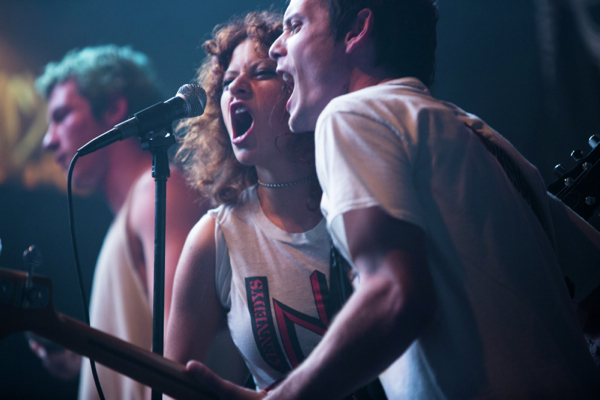Movie review by Greg Carlson
“Green Room,” writer-director Jeremy Saulnier’s follow-up to the taut and terrific revenge thriller “Blue Ruin,” is one of the year’s best, an elegantly realized nightmare made with savvy and smarts. The simple logline – a touring punk quartet runs afoul of a gang of murderous, racist skinheads – belies the level of craft Saulnier brings to what could so easily be another Old Dark House/And Then There Were None genre exercise. In my 2014 review of “Blue Ruin,” I concluded by noting that one of Saulnier’s strengths could be found in the way he invested in some humanity for the antagonists, and that impulse continues in “Green Room.”
A number of critics who praised “Blue Ruin” have claimed that “Green Room” is an even better movie. I will not necessarily argue with that position, keeping in mind that the two films share several similarities but also demonstrate some key differences. Both movies apply surgical precision to the structural elements and pacing conventions of their respective subgenres. Both movies also deliberate on the kinds of details that bring the protagonists and the villains to life. Both movies also draft strong senses of place. “Green Room” is not the first movie to capitalize on the frightening image of the neo-Nazi, even though Saulnier’s agenda differs from those witnessed in films like “Romper Stomper,” “American History X,” and “The Believer.”
One pure, crystalline example of Saulnier’s diabolical sense of pitiless, wrong-place-wrong-time circumstance is the achingly unfair and unfortunate way in which the four members of the Ain’t Rights (finely inhabited by Anton Yelchin, Alia Shawkat, Callum Turner, and Joe Cole) and their unlikely ally Amber (Imogen Poots) find themselves in the slowly clenching jaws of doom: an unlocked door and a forgotten phone lead to the accidental but fate-sealing knowledge of an awful crime. I actually believed that the white supremacists would have much preferred to send the band quickly on their way.
The presence of beloved Patrick Stewart in the role of Darcy, the cold and brutal father figure to the nest of rural hatemongers in suspenders and red-laced combat boots, makes for a wicked piece of unexpected casting and further cements Saulnier’s against-the-grain construction of the familiar (as opposed to the alien) evildoer. Darcy’s relationship with the seemingly luckless Gabe, played by key Saulnier collaborator Macon Blair, as well as to several other “true believers,” confronts the viewer with an uncomfortable, even grotesque level of sympathy for the eager followers yearning to belong to something.
A.A. Dowd’s perfect description of “Green Room” as the “bastard lovechild” of “one of Kelly Reichardt’s portraits of life on the Oregon fringe with one of John Carpenter’s castle-siege action vehicles” hints at the directorial confidence of Saulnier without fully accounting for the filmmaker’s mesmerizing, even disturbing, consideration of violence. Gorehounds will be attracted to “Green Room” for the sophisticated renderings of all manner of grisly trauma, but as he did with his previous feature, Saulnier really soars by making space for the audience to recoil in horror at the consequences of senseless mayhem.
